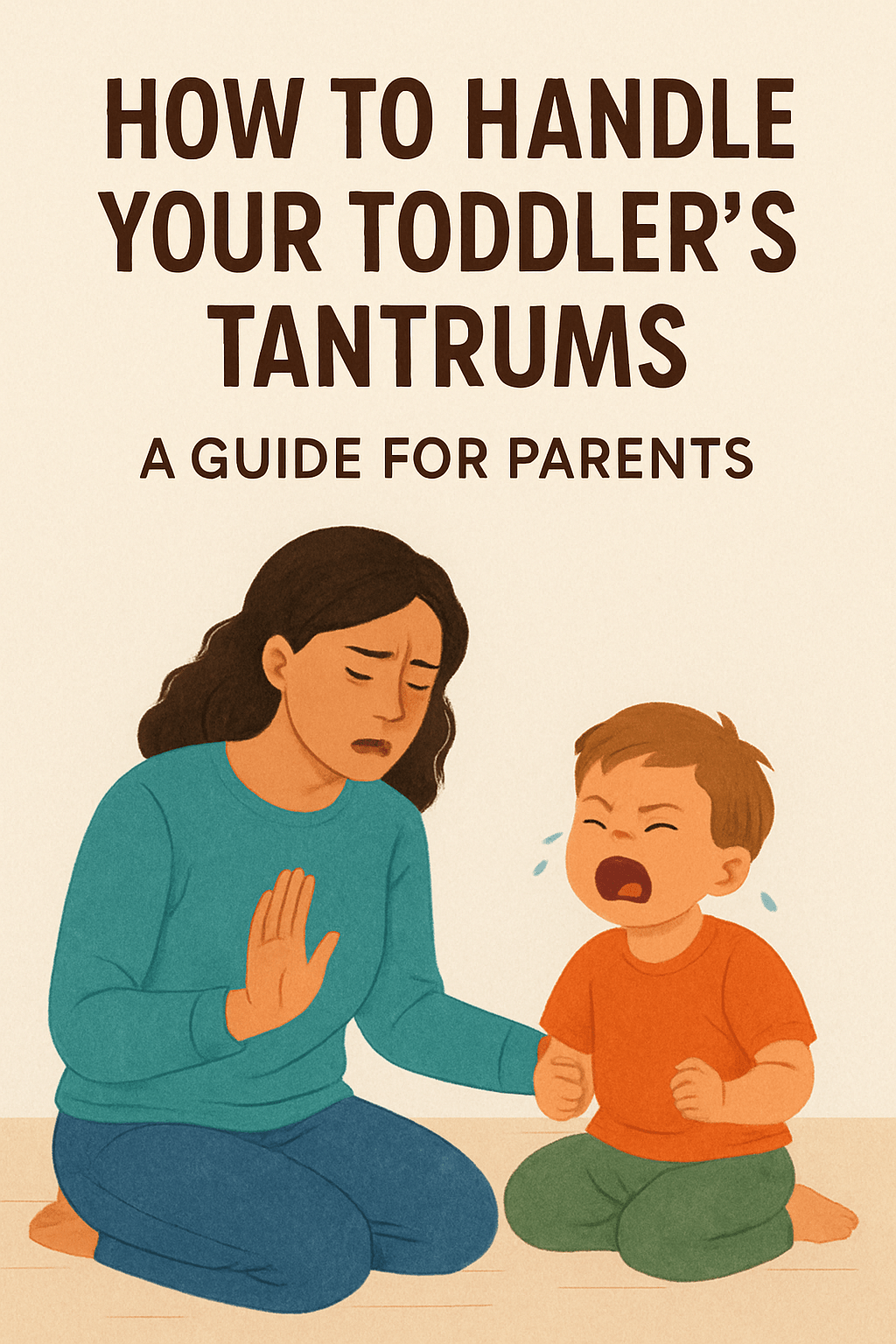
simply amazing, always for you.
The Toddler Tantrum Storm
Tantrums are a normal part of toddlerhood. But when your child is on the floor screaming at the top of their lungs, “normal” doesn’t feel very comforting. Whether it happens in the middle of a grocery store or at bedtime, tantrums can leave even the calmest parent feeling overwhelmed and helpless.

The good news? Tantrums are manageable. With patience, empathy, and the right tools, you can not only get through them but also use them as opportunities to teach your child essential life skills like emotional regulation and communication.
In this guide, we’ll explore:
- Why toddlers throw tantrums
- What not to do during a meltdown
- Proven strategies to defuse tantrums
- Preventive measures to reduce tantrum frequency
- When to seek help
Let’s dive in.
1. Why Do Toddlers Throw Tantrums?
Understanding the root cause of tantrums is the first step toward managing them. At this age, your child is still developing emotional regulation, impulse control, and communication skills. Tantrums happen when:
- They can’t express what they want: Toddlers often know what they want but don’t yet have the language to explain it.
- They’re overwhelmed by emotions: A toddler’s brain is still developing and can be easily hijacked by big feelings like anger, frustration, and sadness.
- They’re tired, hungry, or overstimulated: Basic needs often trigger meltdowns.
- They’re seeking independence: This is the age when children start asserting themselves—“I do it myself!” is a common phrase.
- They’re testing boundaries: Toddlers push limits to understand rules and consequences.
To help your toddler navigate these behaviours effectively, it’s important to learn how to set boundaries with your children (without feeling bad). Boundaries not only reduce tantrums but also create a sense of security for your child.
2. What Not to Do During a Tantrum
Sometimes, how you respond can escalate or de-escalate a tantrum. Here’s what to avoid:
- Don’t yell back: It adds fuel to the fire and models the wrong behavior.
- Don’t give in just to stop the crying: This teaches them that tantrums get results.
- Don’t shame or punish harshly: This damages trust and doesn’t address the root cause.
- Don’t try to rationalize immediately: A toddler in meltdown mode isn’t in a state to listen or learn.
Instead, focus on staying calm, empathetic, and present. If you need guidance, refer to our post on how to discipline your child without yelling or punishing for constructive alternatives that keep connection at the centre.
3. What to Do During a Tantrum
Stay Calm (Even When You Want to Scream)
Your child mirrors your energy. If you remain calm, you help them calm down faster. Deep breaths help, and silently counting to ten can give you space to respond instead of react.

Acknowledge Their Feelings
Validate what they’re experiencing:
- “You’re really upset because you wanted that toy. I hear you.”
- “It’s hard when we can’t have what we want, isn’t it?”
This helps them feel understood.
Give Them Space—Or a Hug
Some kids need room to vent; others want comfort. Learn what your child responds to. A gentle hug can sometimes interrupt the tantrum spiral.
Keep Them Safe
If your child is hitting, throwing things, or at risk of harm, gently remove them from the environment. Hold them if necessary, but not as a punishment—more like a calm container for their storm.
Wait It Out
Tantrums usually pass in a few minutes. Don’t force your child to stop. Let the emotions run their course.
Need more ideas for peaceful discipline? Try these 7 positive discipline strategies every parent should try.
4. What to Say After a Tantrum
When your child is calm, talk about what happened. Use simple language:
- “You were really mad when we had to leave the park.”
- “Next time, you can say, ‘I’m sad’ instead of screaming.”
This is your golden moment to teach emotional vocabulary and better ways to express themselves.
Avoid lectures. Keep it short and supportive. The goal is to help them learn from the experience, not feel guilty about it.
5. How to Prevent Future Tantrums
While you can’t prevent every tantrum, you can reduce their frequency by being proactive:
Stick to a Routine
Toddlers feel more secure with predictable routines. Regular nap times, meals, and playtime help regulate their emotions.
Offer Limited Choices
Instead of asking “What do you want to eat?” say “Would you like an apple or banana?” This gives them a sense of control without overwhelming them.
Teach Emotional Words
Use books, songs, and conversations to teach emotions: happy, sad, mad, tired. The more they can label their feelings, the fewer meltdowns you’ll face.
Praise Positive Behavior
Catch your child being good and praise it specifically: “You waited so patiently—great job!”
Watch for Triggers
Keep notes on when tantrums happen. Is it always before lunch? Right after preschool? Identifying patterns can help you plan ahead.
Looking for shortcuts to ease daily parenting stress? Check out 10 simple parenting hacks every mom and dad should know.
6. When Is a Tantrum a Sign of Something More?
Most tantrums are completely normal. But sometimes they signal a deeper issue. Talk to a pediatrician or child psychologist if:
- Tantrums happen several times a day, every day
- Your child regularly hurts themselves or others during outbursts
- Your child doesn’t calm down at all, even with comfort
- There’s little or no communication or eye contact
- Your gut tells you something feels “off”
Early intervention can make a big difference. And remember, you’re not alone—many parents share the same concerns.
7. Real-Life Tantrum Scenarios and How to Handle Them
Grocery Store Meltdown
What to Do: Acknowledge (“You’re upset we can’t buy candy”), set the boundary (“We’re not buying candy today”), and offer distraction (“Can you help me find the apples?”).
Bedtime Tantrum
What to Do: Stick to the bedtime routine. Offer comfort, not negotiation. Validate feelings: “It’s hard to stop playing. Let’s read your favorite book first.”
For more ideas, read our article on how to balance parenting and personal time without feeling guilty. It’s all about finding calm in the chaos.
Public Tantrum with Judging Eyes Around
What to Do: Focus on your child, not the audience. Stay calm, remove your child if needed, and deal with stares later. You’re parenting, not performing.
8. What If You Lose Your Cool?
You’re human. Every parent has a breaking point.
- Apologize: “I’m sorry I yelled. I was frustrated, too.”
- Repair the bond: Hug, reconnect, and move on.
- Reflect: What triggered you? How can you care for yourself better next time?
Learn practical ways to stay emotionally regulated in how to be a patient parent: tips for managing your emotions. And if you’re feeling drained, see how to deal with parenting burnout and find your energy again.
9. Remember: Tantrums Are a Phase, Not a Failure
You’re not a bad parent because your child throws tantrums. You’re raising a little human who is still learning how to handle big emotions. It’s hard work—but the time and patience you invest now will pay off later in emotionally intelligent, resilient kids.
Parenting is messy, imperfect, and real. And you’re doing better than you think.
Handling toddler tantrums isn’t about stopping them completely.
It’s about helping your child feel safe, seen, and supported through their emotional storm. The more you stay calm and connected, the more your child learns how to manage their own emotions in healthy ways.
And remember: You’ve got this—even on the toughest tantrum days.

Support Our Website!
We appreciate your visit and hope you find our content valuable. If you’d like to support us further, please consider contributing through the TILL NUMBER: 9549825. Your support helps us keep delivering great content!
If you’d like to support Nabado from outside Kenya, we invite you to send your contributions through trusted third-party services such as Remitly, SendWave, or WorldRemit. These platforms are reliable and convenient for international money transfers.
Please use the following details when sending your support:
Phone Number: +254701838999
Recipient Name: Peterson Getuma Okemwa
We sincerely appreciate your generosity and support. Thank you for being part of this journey!
